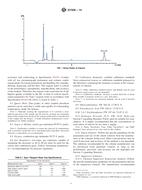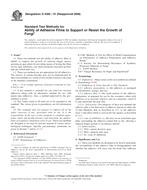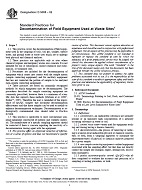1.1 This guide covers some general information on the selection and application of behavioral methods useful for determining the sublethal effects of chemicals to fish, amphibians, and macroinvertebrates.
1.2 Behavioral toxicity occurs when chemical or other stressful conditions, such as changes in water quality or temperature, induce a behavioral change that exceeds the normal range of variability (1). Behavior includes all observable, recordable, or measurable activities of a living organism and reflects genetic, neurobiological, physiological, and environmental determinants (2).
1.3 Behavioral methods can be used in biomonitoring, the determination of no-observed-effect and lowest-observed-effect concentrations, and the prediction of hazardous chemical impacts on natural populations (3).
1.4 Behavioral methods can be applied to fish, amphibians, and macroinvertebrates in standard laboratory toxicity tests, tests of effluents, and sediment toxicity tests.
1.5 The various behavioral methods included in this guide are categorized with respect to seven interdependent, functional responses that fish, amphibians, and macroinvertebrates must perform in order to survive. These functional responses include respiration, locomotion, habitat selection, feeding, predator avoidance, competition, and reproduction (4).
1.5.1 The functional responses are not necessarily mutually exclusive categories. For instance, locomotion, of some form of movement, is important to all behavioral functions.
1.6 Additional behavioral methods for any category may be added when new tests are developed as well as when methods are adapted to different species or different life stages of an organism.
1.7 This guide is arranged as follows:
| Section Number | |
| Scope | 1 |
| Referenced Documents | 2 |
| Terminology | 3 |
| Summary of Guide | 4 |
| Significance and Use | 5 |
| Interferences | 6 |
| Test Facility | 7 |
| Water Supply | 8 |
| Safety Precautions | 9 |
| Test Material | 10 |
| Test Organisms | 11 |
| Responses Measured | 12 |
| Behavioral Test Method Selection Criteria | 13 |
| Experimental Design | 14 |
| Acceptability of Test | 15 |
| Calculation of Test Results | 16 |
| Report | 17 |
1.8 The values stated in SI units are to be regarded as the standard.
1.9 This standard does not purport to address all of the safety concerns, if any, associated with its use. It is the responsibility of the user of this standard to establish appropriate safety and health practices and determine the applicability of regulatory limitations prior to use. Specific precautionary statements are given in Section 9.
Product Details
- Published:
- 10/01/2007
- Number of Pages:
- 9
- File Size:
- 1 file , 120 KB


